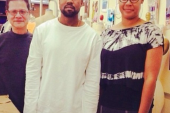
(Photo: Amanda Venner via Flickr Creative Commons) There are girls, and then there are girl crushes. They can be, but aren’t usually, the same as boy’s crushes; our pin-ups have qualities that are harder to pin down than Victoria’s Secret curves and Crest smiles. They’re the new “strong female characters,” females who are strong when they need to be, but are also messy, adorable, complicated–in short, kinda like us, but under a soft-focus spotlight. They’re women like Sofia Coppola, Patti Smith, Charlotte Gainsbourg, all enchanting, stringy brunettes. They’re women like Lana Del Rey, whose ability to morph into her own girlcrush, a sort of streetwise Marilyn Monroe, has captivated us all. They’re women like Zadie Smith and Shala Monroque. Women like Chloe Sevigny. Women like Mindy Kaling, whose relatability is amplified by the way she embraces girliness sans irony. And women like Jenna Lyons, who is aspirational in the sense of being quietly confident and perfectly soigne, with a wardrobe to inspire closet envy; “Jenna Lyons girl crush,” as New York magazine noted, brings up a half-million Google hits. They’re all smart, babely without being too conformist, and totally, totally crush-worthy. The expression “girl crush,” or the also acceptable “girlcrush,” came into fashion as “frenemy” became pass. It’s more playful than its prim predecessor “role model,” more precise than the gender-neutral “crush.” It’s not a new phenomenon (in 2005, the New York Times published an article titled “She’s So Cool, So Smart, So Beautiful: Must Be a Girl Crush”), but it’s becoming increasingly and significantly popular thanks to a combination of new, niche publications that overtly subscribe to the idea and the ubiquity of Tumblr, whose largest users happen to be women (53.5%), young women under the age of 25 to be exact. For every Ryan Gosling Tumblr, there’s a Tumblr dedicated to equally crush-worthy females. “Girl crush” isn’t necessarily, or usually, sexual; it’s more like a fanciful way of saying you want to be that girl. “It’s a word that entered my subconscious at some point and I started using it. People who understood it understood it perfectly,” explains Thessaly La Force, formerly an editor at The Paris Review and co-creator of the definitive Girl Crush Zine. Along with Jenna Wortham (who daylights as the technology reporter at The New York Times), La Force entertained the idea of creating a zine for quite some time, gestating over a theme all summer before finally delivering the zeitgeisty end product last August. “We set out to document the women who inspire us,” the pair writes in their editor’s letter. “[Women] who define us, the ones who compel us to make GIF after GIF of them, whose books, films, and music we pass around to our friends in an effort to understand our deep-seated and universal fascination with these women.” Inside, there’s a roster of powerhouse writers–super-smart women who’ve written candidly and fervently about other super-smart women they admire: Zan Romanoff writes about her patron saint Joan Didion, Mary K. Choi waxes poetic about Cintra Wilson, and Emma Straub swoons over Jennifer Egan. There mightn’t be a Girl Crush Zine if there hadn’t first been Lula, a biannual matte-paper magazine with London-based Canadian Leith Clark at its helm. Since its inception in 2006, it’s featured Kirsten Dunst, Karen Elson, Zooey Deschanel, and the Rodarte designers in a no-hearts-barred adoring way; its tagline is, self-explanatorily, “Girl of My Dreams.” Clark has said she started Lula in part because she didn’t like the way fashion magazines looked at women; “there seems to be this imaginary man in the room,”she told Toronto Standard style editor Sarah Nicole Prickett in an interview for Dazed Digital. In the pages of Lula, the male gaze is erased. It’s all teenage-dreamy, girl-on-girl romance. So is Rookie, the new Sassy-inspired online magazine; this month’s theme? “Girl Gang.” If Lula and Rookie are too innocent-seeming for you, there is now The Gentlewoman, a compendium of smart, fully grown women, compiled by same. Founded last year by former SHOWStudio editor-in-chief Penny Martin, its mandate is less pomp and circumstance, more quiet, earnest, intimate and intellectual conversations between women. In her interview with Dazed Digital, Martin says she wanted to create a personality-based magazine for women of a sort that’s been absent since the seventies. The implicitly feminist sentiment of the girlcrush still belongs to such independent mags and zines, even though the word is frequently borrowed by mainstream media. In fashion magazines, editors slip the word in their copies because it’s current and snappy like other fashion-y words like “chic” and “glam.” But often, it’s just a descriptor eclipsed by screaming Cosmo coverlines like “How to Deal with a Jealous Bitch.” As the recent Jennifer Siebel Newsom documentary Miss Representation points out, characterizations of women in the media include, and are still too often limited to, lascivious “sluts,” greedy “bitches,” and overemotional “headcases” (or, if we’re lucky, all of the above). Those Cosmo coverlines are made possible by the prevailing belief that women just don’t like other women. Girl hate is ubiquitous and inevitable because females are inherently catty, competitive, jealous creatures. Or, as Kate Carraway semi-infamously wrote for Viceland: “It’s less true that girls are jealous of other girls than they are repulsed by themselves. The tall, thin girls want big tits; the milky-creamy thick ones want to go bra-less; the volleyball captains try so hard in their stilettos that it’s kind of hilarious.” These kinds of statements are made as fact rather than opinion; then again, decades of Betty and Veronica-style girl-socializing will go a long way toward making something fact. “We’re told that, as girls, we should hate other girls who are as awesome as or more awesome than ourselves,” writes Tavi Gevinson in a recent post about getting over girl hate in Rookie Mag. As she goes on to (literally) illustrate, this is because girls are only allowed to compete with other girls, and to make matters worse, are taught to think that there’s only so much cake to go around (remember that Courtney Love line?). “Even though women don’t face as big of a fight for equality as the suffragettes or second wave feminists, there’s still a huge gap between men and women in politics, business, medicine and even things like music, television and the culinary world,” says Serah-Marie McMahon, editor of WORN Journal. “Having women to inspire and emulate is crucial.” The rise of the girlcrush seems like a positive shift away from everything that was satirized in Mean Girls, and a necessary corrective to “girl hate.” So then why has the term drawn criticism? When it made its debut, Girl Crush Zine was called juvenile for even using the phrase and likened to Tumblr–the insult being that girlcrushes, like Tumblr, are a frivolous adolescent preoccupation best kept on the interweb with other silly pastimes. “I know some women object to the word crush and yes, using the word ‘girl’ is a little infantilizing. But it also has references to riot grrrl and the punk movement,” says La Force. Or, as Stephanie Rosenbloom pointed out in her 2005 NYT story, the last time young women openly expressed mutual admiration was in the 19th century. “I’m of the belief that being juvenile or silly doesn’t mean you’re not smart, intellectual or thoughtful,” adds La Force. “I still like to wear floral prints and mini dresses. It doesn’t mean that I’m not a serious person.” Plus, what makes a girlcrush more or less juvenile than a bromance? Is it less real than the Ben Affleck and Matt Damon love fest or more inane than a show actually called Bromance? Even if it is a little-girly word, maybe that’s what women need: a reminder of our long-gone, less jaded selves. A reminder of when friendships were pure, healthy, unstained by jealousy. There’s this saying about how jealousy is just love and hate at the same time; either Drake said that or it’s an Arab proverb. But the sentiment behind girlcrushes rejects the lyric-proverb. A girlcrush is simple, unaffected admiration, the propagation of which in girl culture can only be a good thing. And hey, now that Jenna Lyons is dating a woman? The girlcrush just got real. Bonus: Tavi Gevinson, Thessaly LaForce, Chloe Sevigny, Leanne Shapton, Serah-Marie McMahon, Patti Smith… all girls and women we adore, but who’s girlcrushing on who? Find out here.














